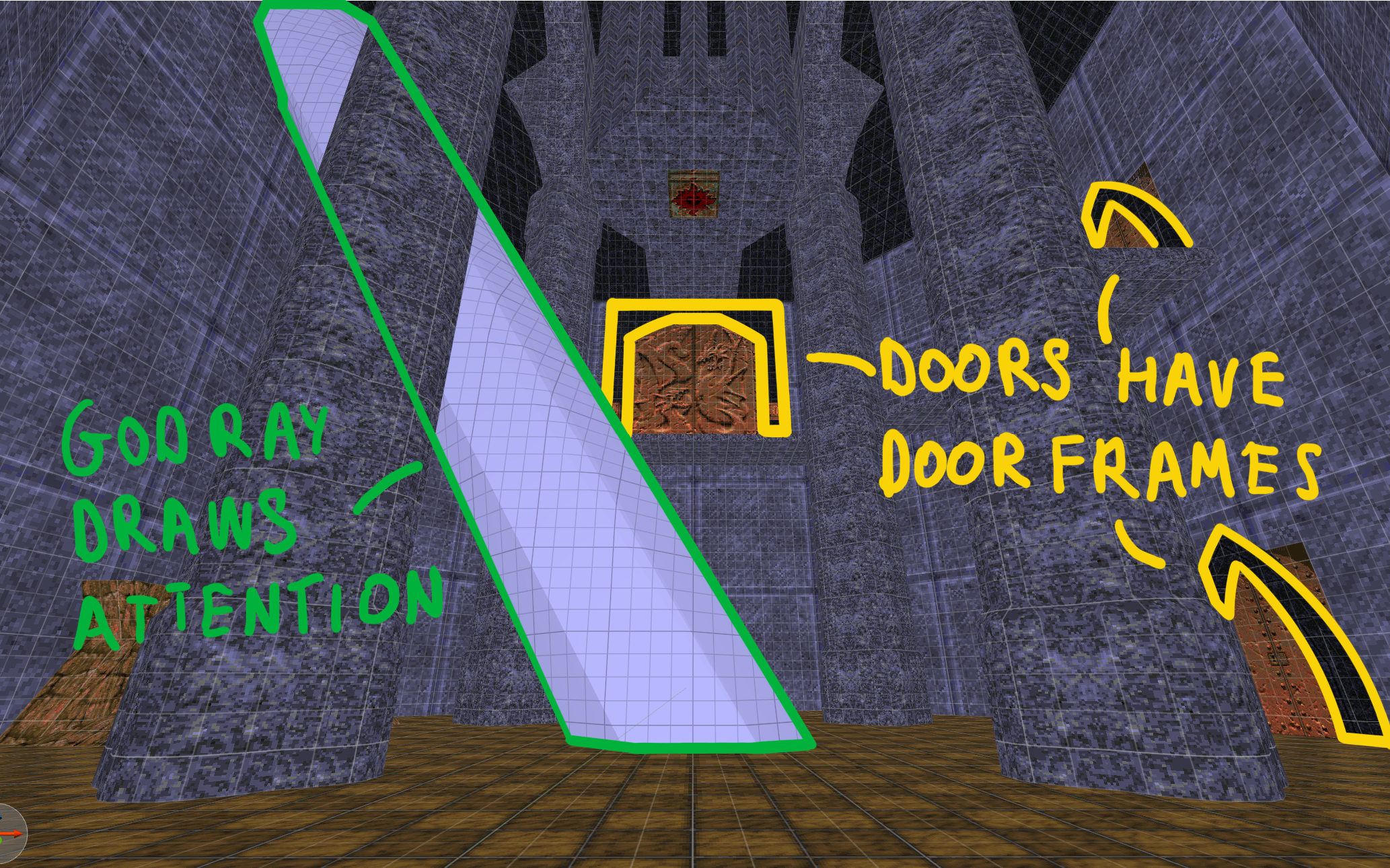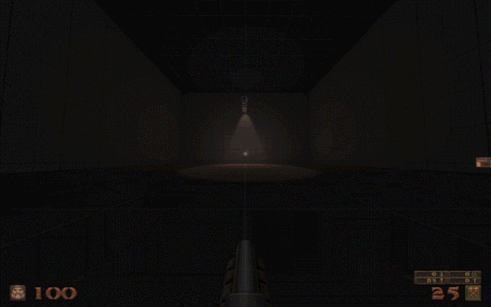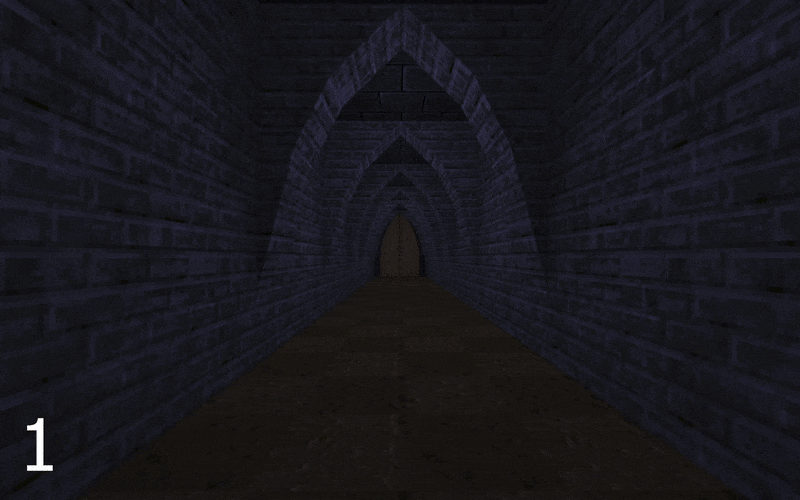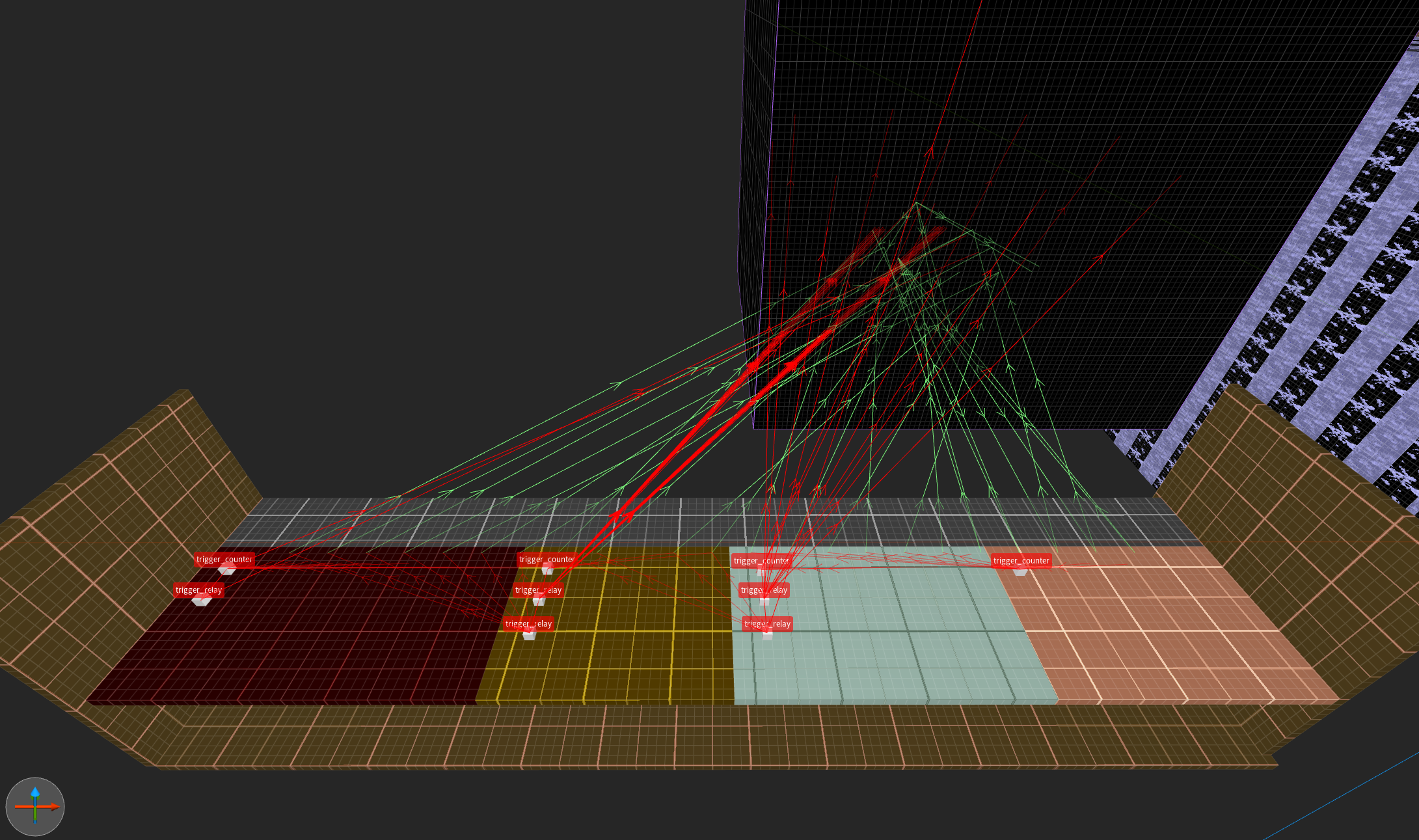
The Eclipsed Sanctum
Level Designer
The Eclipsed Sanctum is a single-player level for the original 1996 Quake, with a heavy focus on caution, dread and fear of the unknown. The goal was to challenge the limits of what a Quake level could be, whilst remaining true to the original game’s player experience.
Individual Contributions
Created a level from concepting to release.
Gathered, sketched and painted over reference images and architecture.
Experimented, measured and tested player metrics in metric gyms.
Blocked out, built and iterated on the layout and gamespaces in TrenchBroom.
Scripted, designed and implemented combat encounters and gameplay beats.
Playtested, analysed and iterated based on data from external playtesters.
Lit, textured and iterated on the dark aesthetics.
Level Overview
Player Fantasy
I wanted to create a haunted, dreadful experience through an abandoned and ruined castle. The player should be wary of their surroundings at all times, but still feel intrigued to discover the secrets of the castle.
The player finds themselves caught in a raging storm whilst on their mission to save Earth – just like the goal in the original Quake story. They seek shelter and see a giant, mysterious castle far in the distance. Creatures once rejected by society have taken over this once highly spiritual place. Their mission requires them to investigate the mysteries of the castle. Are they up to the task?
Design Pillars
Cautious & Dreadful Feeling
The player should approach every room with caution and dread the unknown.
Exploration = Reward
The player should always be encouraged to explore, and should not be restricted from doing so. Exploring should be rewarded.
Haunted Environment
The environment becomes progressively more haunted, as it ‘reacts’ to the player’s intrusion.
Layout & Structure
Implementation
Block-Outs & Iterations
The level went through many iterations throughout production, always informed by playtesting data, to achieve my intended player fantasy. Take a look at how some of the beats evolved during development:
















Lighting
Reaching the Engine’s Capabilities
With the darkness being core to the player experience, it was important to conduct proper research into the lighting capabilities and limitations of the engine, as well as learning about lighting theory in level design.
I dived into the technicality of lighting in TrenchBroom. I learned about all the different variables that a light could have, how to change its colour value, toggle lights on and off, create directional lights, add bounce lighting, change the softness of shadows, and create pulsing and flickering lights.
Through this engine experimentation, I learned about its limits and tried to push those as far as I could. The biggest limitation was that only 4 lights can affect one surface at a time, which ultimately forced me to cut back on some of my ambitions.
You can see the results of the early experimentation that I did: a pulsing spotlight, with 2 bounces of light, which give it gloomy atmosphere.
Let the Light Guide You
Light is a powerful tool to guide the player’s eye, especially in a dark environment. The player is always pulled to the light at the end of the tunnel, so I used this to my advantage to visually leash the player through the level. Doors are dark during combat encounters to keep focus on the enemies, and are subtly lit up once the combat encounter is over, to hint the player towards the next area.
This also applies to secrets. For example, a secret in the Sanctum requires the player to shoot a hidden button. Once shot, the button shows ‘A Yellow Armour has spawned.’ The message doesn’t tell you where. There is a second layer to the puzzle, in the form of a subtle glow coming from behind the rubble, that hints at the location of the Yellow Armour.
It was important to get this right. Dark levels are notorious for being hard to navigate. In The Eclipsed Sanctum, however, the light subtly guides the player throughout the level and makes navigation in the darkness fun, rather than annoying.
Narrative Through Lighting
In order to tell the history of this castle, I used a combination of on-screen text prompts and lighting. This place was once a highly spiritual environment. The inhabitants of the castle used to come here to worship the Ancient Goddess, who blessed them with her kindness and richdom. Evil ghosts, spirits and other creatures have taken over the place, and now, it rests abandoned. The castle has become a hub for cursed creatures, who were rejected by society. The player is disturbing their new home, and they actively fight against the player’s intrusion.
Over the course of the level, the lighting becomes more intense. There are long corridors that the player traverses through as they intrude, and each one has more intense flickering and pulsing lighting than the last. This is a response from the castle and its haunted creatures, that are trying to drive the player out of the castle.
Although there weren’t any combat beats in these corridors, players found these corridors to be narratively extremely intense, and built up a lot of suspense. The fear of the unknown was a very powerful tool that I took advantage of. The danger that’s in your head is bigger than the danger that you see. In one corridor, I sneakily spawned a loud barking dog behind the player. It goes down in two shots, but this surprise gave many players a genuine jump-scare.
The final boss fight, which takes place inside the mysterious cage that has been intriguing the player the entire time, employs a similar concept. For the first two phases, the lighting comes from inside the cage, creating an inviting, comfortable and soft glow. After the player defeats the second phase, lights turn off entirely for a second, which builds up immense suspense. Whilst the player is dreading the horrors that are to come, the lights turn back on, but this time, the light is coming from outside the cage. This creates harsh, dramatic shadows, perfect for the final encounter.
The power of lighting to enhance the atmosphere cannot be overstated, and I used this power appropriately throughout the level to deliver my intended player experience.
Adaptive Lighting Based on the Player’s Progress
Depending on how far the player has progressed throughout the level, the lighting changes accordingly. As the player makes their way up the castle, they enter the Sanctum room multiple times.
The first time the player can see the Sanctum, they get a glimpse through the bars of a locked gate. The lights in the Sanctum are very dark, and the player’s eye is pulled towards the god ray shining on the golden key.
The gates open once the player finishes the previous combat encounter. Now, the area is brighter, so that the player can explore the space and fight the enemies in this room. The ceiling is hidden, implying that it is so high that you can’t see it.
From here, the player climbs through the Double Elevator room, and then returns to the Sanctum. This time, the lights on the ground are turned off, and there is a light shining from the cage, casting beautiful shadows on the walls.
Modularity & Scripting
Modular Kit
To streamline my workflow, I created a modular kit for developing my level. This modular kit was created in a separate gym level that I used for quickly changing, testing and iterating on gameplay beats. This gave me more freedom to play around with geometry, enemy placement, etc. whilst not messing with the main level. Changes were always vetted in the gym first, ensuring that I always had a back-up, before they were migrated to the main level.
To speed up the process even more, I set up linked groups inside of the main level. This feature of TrenchBroom allowed me to make a change to one asset group (e.g. a group of assets creating a pillar), and every single group that is linked to it would receive the same changes.
This modular approach allowed me to remain focused on what’s most important: the gameplay and player experience. With the time saved, I was able to spend more time polishing the experience and enhancing the quality of the output.
Scripted Sequences
I used scripted sequences all throughout the level to balance the combat and add a dynamic element to the level. Timers, counters, triggers and more were crucial tools to ensure a balanced gameplay loop and keep the player in the flow.
Combining these tools allowed me to create unique player experiences not previously seen in Quake. For the boss fight, I set up 4 different waves of enemies that spawn as the previous one is defeated. As the encounter progresses, and the player is running low on resources, health packs and ammo will respawn. The lighting changes between wave 2 & 3 to increase the tension in the room and in the final wave, some cover even disappears from the battlefield, forcing the player to find new ways to defeat the foes.
Scripted sequences were the solution to many of the problems I faced, and provided unique and creative solutions that make for memorable experiences.
Pacing & Intensity
Balancing Gameplay with Narrative
During the development of the level, it was important to balance the gameplay intensity, mostly coming from the difficulty, with narrative intensity, which comes from the environment, on-screen text prompts, and the lighting.
I designed the beats so that the gameplay and narrative intensity alternate between the rooms. Rooms with combat encounters have little narrative in them. The connectors between the combat beats give breathing space to the player, but have a higher narrative intensity. They build up tension and prepare the player for the next combat beat.
Throughout the level, I also make ‘statements’ to the player. The start of the level grants you a Super Nailgun, a very powerful weapon in Quake. This already sets expectations that what’s behind the door is probably not the easiest of encounters, and that the player will have to buckle up if they intend to make it out alive.
Intensity
Retrospective
Working on The Eclipsed Sanctum was an exceptionally insightful experience, with many learnings along the road, from big to small.
The concepting phase was the hardest of them all. I cannot stare at a blank canvas, but I’ve found different ways to inspire myself. I’ve learned how to put my ideas on paper, using visuals when necessary, to effectively communicate my intentions with peers.
Working in TrenchBroom, whilst daunting at first, was a delight. Learning about all the tools and pushing the limits of the engine was a challenging yet rewarding process. From scripting, to lighting, to modelling and texturing, every part of the process was a different beast to tackle, but was made accessible thanks to the help from the Quake Mapping community.
The constraints of the engine fostered my creativity and forced me to come up with creative solutions to unique problems. With every playtest, the quality of the level gradually improved, and more smiles - or should I say fears - appeared on players’ faces.
Going through the full process, from concepting to lighting and texturing, helped me get a better understanding of the full level design pipeline, which will prove valuable in future projects!




















